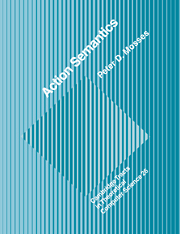Book contents
- Frontmatter
- Contents
- List of Boxes
- Preface
- Part I Introduction
- Part II Action Notation
- Part III Semantic Descriptions
- Chapter 11 Statements
- Chapter 12 Literals
- Chapter 13 Expressions
- Chapter 14 Declarations
- Chapter 15 Variables
- Chapter 16 Subprograms
- Chapter 17 Tasks
- Part IV Conclusion
- Appendices
- Bibliography
- Symbol Index
- Concept Index
Chapter 17 - Tasks
Published online by Cambridge University Press: 19 January 2010
- Frontmatter
- Contents
- List of Boxes
- Preface
- Part I Introduction
- Part II Action Notation
- Part III Semantic Descriptions
- Chapter 11 Statements
- Chapter 12 Literals
- Chapter 13 Expressions
- Chapter 14 Declarations
- Chapter 15 Variables
- Chapter 16 Subprograms
- Chapter 17 Tasks
- Part IV Conclusion
- Appendices
- Bibliography
- Symbol Index
- Concept Index
Summary
Task declarations initiate concurrent processes, which can synchronize using entry calls and accept statements. The select statement may now iterate until an entry call can be accepted.
The semantics of task declarations illustrates the use of the communicative action notation introduced in Chapter 10.
Semantic entities now include agents, and various signals sent in messages. They also include entities that represent open alternatives of selections.
Let us first consider the treatment of input and output in programming languages. By definition, the input of a program is the information that is supplied to it by the user; the output is the information that the user gets back. However, it is important to take into account not only what information is supplied, but also when the supply takes place. We may distinguish between so-called batch and interactive input-output.
With batch input, all the input to the program is supplied at the start of the program. The input may then be regarded as stored, in a file. Batch output is likewise accumulated in a file, and only given to the user when (if ever) the program terminates. On the other hand, interactive input is provided gradually, as a stream of data, while the program is running; the program may have to wait for further input data to be provided before it can proceed. Similarly, interactive output is provided to the user while the program is running, as soon as it has been determined.
- Type
- Chapter
- Information
- Action Semantics , pp. 195 - 204Publisher: Cambridge University PressPrint publication year: 1992

